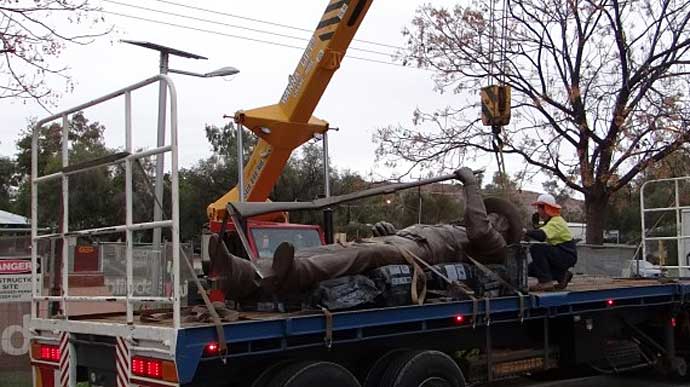Statue of White man holding a gun installed in Alice Springs
John McDouall Stuart was a Scottish explorer in the 19th Century, who had at least two conflicts with First Nations people during his explorations moving northerly from Adelaide, South Australia.
As with all of the illegal invaders who 'explored' inland Australia he was considered a hero by his White contemporaries and many places are named after him, including a town, street, highway, suburb, park, mount, avenue and even an electoral division.
Alice Springs was originally named Stuart, which was changed to Alice Springs in 1933 and there are statues honouring him in Victoria Square, Adelaide, while in Darwin, both a statue and a monument celebrate his 'achievements'.

Mark Egan’s representation of explorer John McDouall Stuart was placed on the Freemasons pedestal on 23 July 2014.
(aliceonline.com.au)
Emma Sleath www.abc.net.au 23 July 2014
A statue of explorer John McDouall Stuart has been erected in the centre of Alice Springs after four years of fierce community debate.
The four-metre tall iron and concrete colossus was commissioned by the Stuart McDouall Freemasons Lodge in Alice Springs in 2009 to commemorate the 150th anniversary of the Scotsman-freemason reaching the town.
But following news of the statue and its planned unveiling, concerns were raised that council had bypassed its own committee (the Public Art Advisory Committee) in accepting the gift.
There were also questions about the appropriateness of a five-metre high statue of a white man holding a rifle in a town sensitive to racial tensions.
The statue also features a pyramid-shaped plinth, suspected by some in the town as being Masonic symbolism.
It has taken four years for the council to find the statue a permanent home.
In the same amount of time Stuart completed his life's achievement of six expeditions traversing the Australian mainland from north to south.
Stuart is recognised as one of the most accomplished of all Australia's inland explorers and is the namesake of the 2,800 kilometre Stuart Highway linking Port Augusta with Darwin.
His statue was unveiled on the council lawns in 2010 for the Stuart anniversary and then given back to its creator, sculptor Mark Egan, to store on his property outside of town.
There was standing-room only at a 2010 public meeting at council to discuss where to install the statue, former member of the PAAC Lisa Stefanoff said.
"A range of points were raised in opposition to it then," she said.
"I can't imagine those voices have gone away."
Ms Stefanoff, an Honorary Associate of Charles Darwin University, said there were unanswered questions over exactly what was being commemorated.
"It became apparent that the plinth, that the statue was to stand on, is a shaved off pyramid which people might know as a Masonic symbol," she said.
"It seemed that the statue was a kind of a cipher for another kind of memorialisation."
In March 2013 council voted to erect the statue on Stuart Terrace near Alice Springs Hospital, and one block away from its original home on the council lawns.
Since then there has been speculation that negotiations between the lodge and the council broke down over the arrangement that the lodge would cover installation and maintenance costs.
Council CEO Rex Mooney said the decision was made to take on these costs in the interest of expediency.
"The Freemasons indicated that they didn't have any funds to support these expenses," he said.
John McDouall Stuart statue unveiled

Photo: John McDouall Stuart statue is unveiled in Alice Springs, August 6, 2010.
(ABC News: Kirsty Nancarrow)
"The council felt that it was going on too long.
"There had to be a decision made to erect the statue.
"It was gifted to the council, to the community, so the council took that proactive action and accepted those costs."
He said graffiti and vandalism costs the council $2,000 per week.
"[This includes] all of council's public facilities, sporting events, street signs, windows and so on, so [the statue] would obviously be part of that cost," he said.
He said the divisive statue was no longer an issue.
"Everyone is entitled to an opinion, and certainly those opinions were expressed," he said.
"There were many comments about holding a gun, there were many comments about why not hold a gun?
"But in the balance of all those discussions I think there has been an acceptance that that was part and parcel of an early explorers apparel and armament."
Since the statue was donated to the council, the instigator of the idea, Worshipful Master Les Pilton, has been replaced at the helm of the McDouall Stuart lodge.
Mr Mooney said he had been having "very cordial and fruitful discussion" with the current Worshipful Master, Eric Neil.
"I conveyed the council's decision to proceed to install the statue at Stuart Park," he said.
Mr Neil declined to comment further other than to say that the lodge were "happy to work with council as to what they want and how they want to go about it".
Sculptor Mark Egan said he was happy the public would finally see his work.
"When all is said and done, more is said then done," he said.
"I don't know, it's just damn annoying.
"There are too much complication, too many rules and regulations.
"It makes you wonder whether it's all worth while in the end.
"Like you'd think it would be so easy - it's just a bit of artwork and it's not easy."

